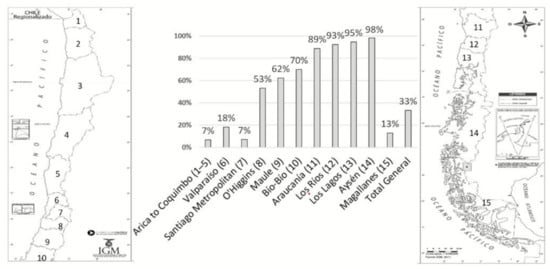1000/1000
Hot
Most Recent

Chile is a country that is highly dependent on importing energy, particularly fossil hydrocarbons, even though it possesses a variety of energy resources that are relatively well distributed. Around 24% of the country’s power grid comes from forest-based biomass, with firewood being the most-used energy source, mainly for heating and cooking purposes: 97% of firewood is used for heating, and the other 3% is used for domestic water heating and, in some cases, for cooking food. Given that firewood is used by thousands of people during the year, wood burning has had severe social and environmental consequences in densely populated cities such as Temuco. These consequences are mainly due to biomass combustion, which is an important source of particulate matter stemming from the incomplete combustion of components like cellulose, hemicellulose, and lignin, in addition to temperature-produced changes caused by combustion from uncontrolled sources.
The average annual consumption of firewood in a Chilean household depends greatly on the location, due to two fundamental aspects. The first is the geography of the country, where the rainiest and coldest areas are located mainly in the south, starting from the O’Higgins region to the Magallanes region, while the warmest areas are located in the north, starting from the Metropolitan region to the region of Arica y Parinacota. From west to east is the coastal area to the mountain range, where the mountain range zone sees more severe weather than the coastal area, which implies a higher consumption of firewood, encouraged by the abundance of biomass compared to other energy sources such as electricity, fossil fuels, and other sources such as geothermal waters, solar panels, and others. The second is the economic factor, since the country has large socio-economic differences that directly affect access to technologies and fuel for people in the south because the poverty rate is close to 17%, mainly in the Araucanía region [1]. This poverty rate in the area means that new technologies focused on house improvements, such as thermal insulation and efficient domestic heating, are not feasible for this percentage of the population. According to the latest government reports, fuel poverty in the region has reached 23% and 29% corresponding to the inhabitants without access to electricity supply and domestic hot water [2], which is directly proportional to the socio-economic status of each region; therefore, the few options for the most vulnerable part of the population to acquire biomass stoves are wood-burning stoves, due to its easy installation, versatility, and low price, which is a feasible alternative for this socio-economic sector.

Figure 1. Household use of forest biomass in Chile [7].
Figure 1 shows the percentage of firewood consumption by region. Considering the availability of forest resources on a national scale, the highest percentage of firewood consumption and use is in the central-southern zone of the country. This is not surprising, as these are the climatologically colder zones and are located closest to the forest biomass production zones. According to the figures, consumption increases in the fall–winter months (May–August) and is mainly concentrated in the lowest socio-economic sectors [8].
The main wood-burning devices are salamander stoves, open chimneys, simple stoves, double chamber stoves, braziers, and handmade equipment. All of these devices are used, although some are more characteristic in certain areas. The wood fuel in these devices generates fine particulate matter emissions (PM2.5), carbon monoxide, volatile components, nitrogen oxides, and other pollutants. As for CO2 emissions, firewood is considered neutral [4].
Of the contaminants mentioned [9], the main problem in Chile is particulate matter (PM2.5 and 86 PM10), given the large impact on human health [10] that continuous exposure to these particles represents.
Combustion of the wood starts when the biomass is exposed to caloric energy. It is followed sequentially by hydrolyzation, oxidation, drying, and pyrolysis, which increases the temperature to form a gaseous fuel. These substances are highly reactive and derived from carbon [11]. The process is as follows: 1. when the wood is exposed to a heating source, its elements start to hydrolyze, dehydrate, and burn as the temperature increases. This process produces volatile fuels, tarry substances, and highly reactive carbonaceous char. 2. When the ignition temperature of these volatiles and chemically treated substances is reached, the combustion process begins. 3. The heat generated by the combustion flame provides the necessary energy for the biomass to gasify and for the flame to spread, further evaporating the water that is found within the cell walls of the biomass, known as the water capillary action. 4. Then, the volatile products (such as water vapor, resinous compounds, and decomposing cell products), the hemicelluloses, and the lignin are separated to then be partially or completely combusted in the flame zone. During combustion, carbon continues to form until the flow of biomass gas falls below the minimum level required to keep the flames. During the flaming combustion, the formation of carbon continues until the volatile fuel flow drops below the minimum level required for the dispersion of the flame. 5. Finally, the smoldering process or the progressive oxidation of the reactive carbon starts. The biomass combustion is characterized by a non-premixed and turbulent flame, given that there is no mixing prior to the combustion reaction between the air and the fuel. In this process, large quantities of particles, which vary in size according to their physical and chemical properties, are emitted into the atmosphere. They can be divided into two categories: non-carbon-based particles, which are generated by non-flammable elements within the fuel, possess neither carbon nor hydrogen atoms [12], and include residual elements that detach from the surface of the fuel [13]. The second category consists of carbon particles formed by pyrolysis of the fuel molecules, and which have not reacted in the flame zone. Other conditions that contribute to the production of solid particles mainly depend on the level of humidity found in the fuel. At some point, moisture in biomass residues significantly affects your ability to heat [14].